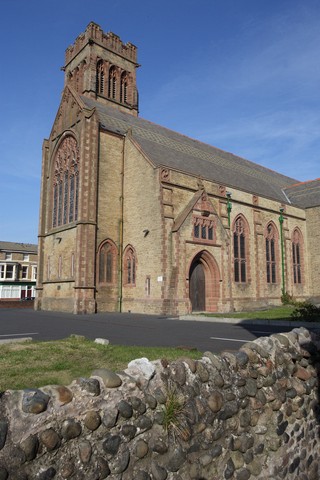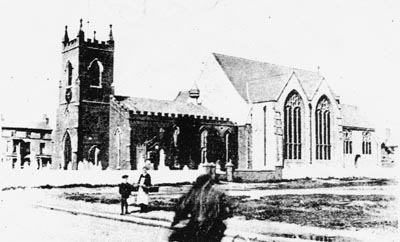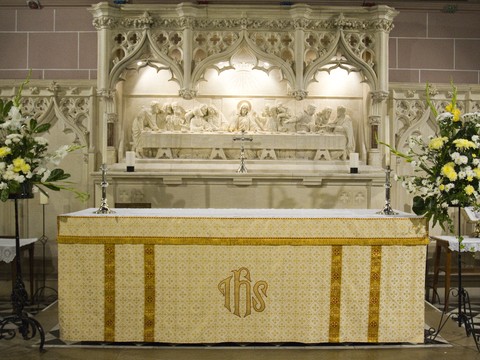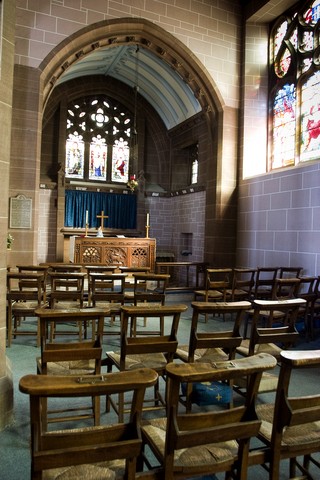About the church
 Holy Trinity is in the South Shore area of Blackpool, it is close to the promenade by South Pier. This map shows how to find us, this page can also be used to generate directions from anywhere in the UK.
Holy Trinity is in the South Shore area of Blackpool, it is close to the promenade by South Pier. This map shows how to find us, this page can also be used to generate directions from anywhere in the UK.
Basic Directions
If you're travelling along the Promenade look out for South Pier, if you're travelling North the turning for Dean Street is the first road after the Pier. If a more inland approach is taken Dean Street is reached off Lytham Road. Again, if travelling North along Lytham Road you will pass over a bridge, the turning for Dean Street is the second road on the left just after the Zebra Crossing.Holy Trinity Church
Dean Street
South Shore
Blackpool
FY4 1BP
History
It is known that the first Church dedicated to the Holy Trinity was built in 1836 on the present site. The first church is described as "a modest building" of an early English type, nestling among the sandhills with long lancet windows, high square pews and deep West gallery. The building accommodated about two hundred and fifty people. | A photo of the church showing the original building (left) and half of the new 1880's building. |
 | Altar and Reredos |
The Grade 2 listed status of the building comes from the two large windows in the South Transept; these can be seen in the photo looking across the sanctuary. The idea embodied in the East window is the building of the Temple of God. The lower lights represent the dedication of Solomon?s Temple (II Chronicles, 6). The middle lights are figures of the four men associated with English Church building; St Edmund the Confessor (Westminster Abbey); William the Englishman (Canterbury Cathedral); William of Wykeham (Winchester and New College, Oxford); and Sir Christopher Wren (St. Paul's Cathedral). The upper lights represent the Holy City, the New Jerusalem. The West window shows the idea of the Temple and Church music. The lower lights show David bringing up the Ark of God from the House of Obededom to the City of David. In the middle lights four of the great Church musicians are shown; St Gregory, whose name is associated with bringing music to the Psalms in the Christian Church; St Dunstan, the first Anglican builder of organs; Marbeck, a great composer; and Purcell another great composer of the Wren period. The upper section represents the Adoration of the Heavenly Host.
There are many other beautiful stained glass windows in the Church, the ones in the South Nave have an interesting story. They depict the four Evangelists (Matthew, Mark, Luke and John) and were originally in Rawcliffe Street Methodist Church. The last service was held there on the 25th July 1971, and in 1972 the church was demolished. Fortunately, these windows were saved from destruction and given to the Church by our Methodist friends.
 | The Burgess Memorial Chapel pictured in 2005 |
An inspection by the Diocesan Architects in 2005 highlighted a lot of work that needed completing urgently to maintain the building for the future. In addition to the maintenance work the opportunity to re-order the church to make the space more useful and relevant to the local community was undertaken. In 2006, after all the planning and having received grants and donations, work began. First a new car park was laid. Internally, at the back of the church, the Childrenâs Corner made way for a kitchen and new toilets, including one for the disabled. All the pews were removed and the nave furnished with chairs. A glass pod, framed in American Oak was built at the back of the church, this has a false ceiling with lights. There is also a small Heritage Centre at the back. The pod is now an excellent place for meetings. The font was removed from the old Childrenâs Corner and is now at the front of the church.
With grants from English Heritage, Historic Churches Trust and other funding, Phase I included the replacement of the north transept windows, exterior stonework, guttering and roof repairs. Due to movement caused by the flagpole in strong winds, a crack had appeared in the tower and the top of the structure had to be rebuilt and a new tower roof added. There was major dry rot work to tackle and for a week the organ remained covered to avoid dust damage. The gallery was also closed.
In January 2010 Phase II with a further grant from English Heritage of the work began with removal of the north and south aisle ceilings for dry rot work and work on the stonework and traceries done. Then in 2014 a further English Heritage grant allowed work to begin on Phase III which involved conservation of the stonework in the South Transept windows and restoration of the stained glass. This was completed in the early summer of 2015 and we are now planning to start Phase IV which includes conservation of the tower stonework and some internal work with a grant from Historic England (previously known as English Heritage).
The church is extremely grateful to have benefited from the financial support from Historic England and all the other organisations and individuals over the last ten years which has enabled the church building to be secured for the current and future generations.

